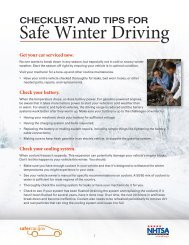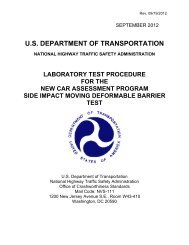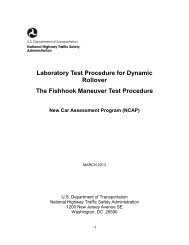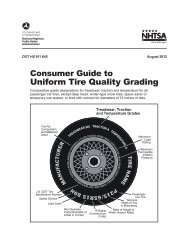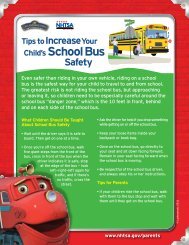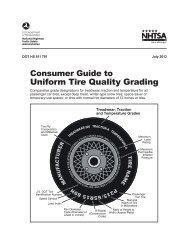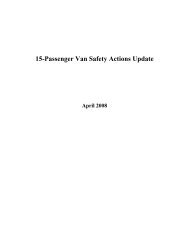Buying a Safer Car 2010: Valuable Information on ... - SaferCar.gov
Buying a Safer Car 2010: Valuable Information on ... - SaferCar.gov
Buying a Safer Car 2010: Valuable Information on ... - SaferCar.gov
You also want an ePaper? Increase the reach of your titles
YUMPU automatically turns print PDFs into web optimized ePapers that Google loves.
www.safercar.<strong>gov</strong> 5<br />
<str<strong>on</strong>g>Valuable</str<strong>on</strong>g> <str<strong>on</strong>g>Informati<strong>on</strong></str<strong>on</strong>g> <strong>on</strong> Crash Tests, Rollover Ratings, and Safety Features<br />
SABs found <strong>on</strong> c<strong>on</strong>vertibles may deploy upwards from<br />
the door window sill. Combinati<strong>on</strong> or “combo” air bags<br />
typically deploy upward from the seat back and provide<br />
both head and chest protecti<strong>on</strong>. SABs providing<br />
chest-<strong>on</strong>ly protecti<strong>on</strong> will have the following footnotes<br />
in the charts depending <strong>on</strong> their installati<strong>on</strong> locati<strong>on</strong>:<br />
door-mounted (d) or seat-mounted (s). Read the owner’s<br />
manual or c<strong>on</strong>tact the manufacturer for specific<br />
informati<strong>on</strong> about the side-impact air bag system in a<br />
vehicle.<br />
SAB Out-of-Positi<strong>on</strong> Tests<br />
A Technical Working Group of experts representing the<br />
automotive and insurance industries developed voluntary<br />
SAB testing procedures to minimize the potential<br />
risk of SAB-related injuries for out-of-positi<strong>on</strong> occupants,<br />
which often include children who sit too close<br />
to an SAB.<br />
Vehicles that have successfully completed the full battery<br />
of tests specified under the voluntary guidelines<br />
will have an “M” for “meets specificati<strong>on</strong>s” in the “SAB<br />
Out-of-Positi<strong>on</strong> Tests” column of the Safety Features<br />
Charts in this brochure. The test results can also be<br />
found by searching the NHTSA vehicle database at<br />
www.safercar.<strong>gov</strong>.<br />
Seat Belts<br />
Seat belts remain <strong>on</strong>e of the most important safety features<br />
in your vehicle. In the event of a crash, seat belts<br />
are designed to keep you inside the vehicle and reduce<br />
the risk of you hitting the steering wheel, dashboard,<br />
or windshield. We recommend that new buyers sit in<br />
a vehicle, buckle up their seat belts, and check the fit.<br />
Proper fit means that the lap belt will rest <strong>on</strong> the upper<br />
thighs and the shoulder belt across the chest. Check the<br />
Available Features chart for each vehicle at www.safercar.<strong>gov</strong><br />
for the availability of additi<strong>on</strong>al seat belt features<br />
such as adjustable upper belt anchorages, seat belt pretensi<strong>on</strong>ers,<br />
energy management features, integrated seat<br />
belt systems, seat belt extenders, and innovative seat belt<br />
reminder systems.<br />
Enhanced Seat Belt Reminder Systems<br />
The purpose of a seat belt reminder system is to remind<br />
vehicle occupants to wear their seat belts. FMVSS No.<br />
208 requires all vehicles to have at least a four- to eightsec<strong>on</strong>d<br />
reminder for the driver. This reminder appears as<br />
a dashboard warning light (often designed as a pers<strong>on</strong> in<br />
a seat belt) that also makes a sound.<br />
Some manufacturers have voluntarily installed<br />
enhanced systems that go bey<strong>on</strong>d FMVSS No. 208 and<br />
provide additi<strong>on</strong>al warnings when drivers and/or other<br />
occupants are not using seat belts. These systems have<br />
visual and/or audio warnings to remind occupants to<br />
buckle up. In additi<strong>on</strong>, some of these systems also sense<br />
how fast the vehicle is traveling, and increase the frequency<br />
of the warning. Some vehicles are equipped with<br />
seat belt reminder systems for rear seat passengers. Visit<br />
www.safercar.<strong>gov</strong> or review the owner’s manual to find<br />
out if the vehicle has an enhanced seat belt reminder<br />
system.<br />
Fr<strong>on</strong>tal Air Bags<br />
Depending <strong>on</strong> the severity of the crash, fr<strong>on</strong>tal air bags<br />
inflate to prevent occupants from hitting the steering<br />
wheel, dashboard, and windshield. Fr<strong>on</strong>tal air bags for<br />
both drivers and passengers have been standard equipment<br />
in all light vehicles since 1998.<br />
Fr<strong>on</strong>tal air bags do not eliminate the need for seat<br />
belts and typically do not offer protecti<strong>on</strong> in rollovers,<br />
side-impact, or rear-end crashes. Air bag effectiveness<br />
depends up<strong>on</strong> the proper use of seat belts, which help<br />
keep you in place should a collisi<strong>on</strong> occur. Occupants<br />
who are unbelted or out‐of-positi<strong>on</strong> can end up being<br />
seriously injured or killed if they are too close to the air<br />
bag when it deploys, particularly if the vehicle does not<br />
have advanced air bags.<br />
Advanced (Fr<strong>on</strong>tal) Air Bag Systems<br />
As of September 1, 2006, all new light vehicles are<br />
required to be certified to the new Federal Standard for<br />
advanced air bags.<br />
Advanced air bag systems are designed to further reduce<br />
the likelihood of serious injury or death to occupants,<br />
whether adults or children, who may be too close to the<br />
air bag when it deploys. Most advanced air bag systems<br />
use sensors that automatically detect the severity of the<br />
crash, the occupant’s size, seat belt use, and/or seating<br />
positi<strong>on</strong>, and deploy the appropriate level of power to<br />
the driver’s and passenger’s fr<strong>on</strong>tal air bags.<br />
You will need to talk with the dealer or review the owner’s<br />
manual to learn more about the specific features<br />
and sensor technologies in use as part of the advanced<br />
air bag system.<br />
Reduce the risk of injury from any fr<strong>on</strong>tal air bag by<br />
observing the following:<br />
Buckle your seat belt.<br />
Keep about 10 inches or more between your<br />
breastb<strong>on</strong>e and the center of the air bag cover<br />
(driver <strong>on</strong>ly).<br />
Never place a rear-facing infant seat in fr<strong>on</strong>t of<br />
an air bag, even a reduced-power or advanced<br />
<str<strong>on</strong>g>Buying</str<strong>on</strong>g> A <str<strong>on</strong>g>Safer</str<strong>on</strong>g> <str<strong>on</strong>g>Car</str<strong>on</strong>g> <str<strong>on</strong>g>2010</str<strong>on</strong>g>



